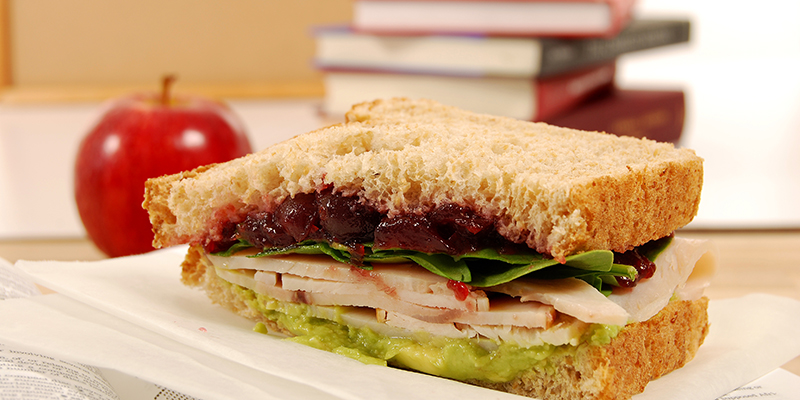 Choicelunch founder explains new USDA school lunch rules
Choicelunch founder explains new USDA school lunch rules
by Dana Woldow, 2012-08-13
New federal regulations for school meal programs took effect July 1, but most students will get their first look at how those rules translate to the lunch tray when they head back to school in the coming weeks. Justin Gagnon, CEO of Choicelunch provides a sneak preview of how the new rules may impact school food.
Q – First, what is Choicelunch?
A – Choicelunch prepares healthy school lunches in our 4 kitchens throughout California for 250+ schools. We offer up to 16 entrée choices daily, and most lunches are pre-ordered by parents on our website or iPhone app. Pre-ordering allows us to offer a wider variety.
Q – Can public schools using the National School Lunch Program afford Choicelunch? Will you bid on the meal contract for San Francisco’s public schools?
A – Parents typically pay about $4.80 for our meal, but the maximum government payment for a “free” lunch in California is about $3. We do run NSLP at several districts, but we typically can only serve districts that have 10% or less of their students on free and reduced price lunch.. Any more than 10% [SFUSD is about 60%] and the price that we would have to charge the paid students in order to offset the shortfall from the government reimbursement becomes too great. We simply can’t deliver on what we do solely within the confines of the current government reimbursement. Because of the regulations and the limit on what the government will pay for a meal, we offer fewer choices at the NSLP schools.
Q – How do the new USDA lunch regulations affect a company that is based on choice?
A – They claim to support a program with choice, but in reality, they’re extremely limiting. For example, there are both daily and weekly minimums, and weekly maximums, of portions for meat/meat alternative and grain. The rules require that the sum of the daily minimums must meet the weekly minimum requirement AND sum of daily maximums must meet the weekly maximum requirement.
What does this mean? Well, if you want to have a turkey sandwich offered with 3oz of turkey every day – sorry, you’re now at 15 servings of meat for the week, which is 5 over the maximum. What about a cucumber or avocado sushi roll that we offer daily? No deal – doesn’t meet the meat minimum unless you pair it with a string cheese. Better hope that kid’s not vegan.
Even before the revised regulations, the menu planner has so many constituencies they need to consider (e.g. gluten-free, vegetarian, allergies, diabetic), not to mention one of the most important – consumer preference. Does it really matter if a meal is perfectly balanced when half of it ends up in the trash?
The recent guidance on the meat and grain maximums are the most difficult for us. How can you hit the increased calorie requirements for the older grades without increasing the maximums of grain and proteins commensurately? Well, there’s one easy way – fat. When your program is already operating well under the fat thresholds, it’s a lever you can pull without still exceeding that fat requirements (and the impact of adding a 9-calorie gram of fat is over double that of a 4-calorie gram of protein or carb), but it’s not one we want to pull because we think it’s ridiculous.
What the maximums are really going to do is force the manufacturers to add more additives and fillers, ala Taco Bell and its 35% beef lawsuit. How do you not go over the 2 oz maximum for meat and still give kids the mammoth servings they have been trained to expect from fast food restaurants? Fillers are one way to get this done.
Our parents are very happy with our menu and our process, and are willing to pay for it. The NSLP is better suited for a situation where a school has high F&R reduced and runs a set menu, so the customer isn’t so much voting with their dollar as they are just stuck with whatever menu configuration the school can get to check off all the boxes with the regulations. The irony is those districts often end up scratching their heads as to why they can’t get better participation from their paid students.
Q – Some people might call your company elitist; how would you respond to that?
The health of our children is a universal concern, and not a problem that is limited to one socioeconomic class. The price of our meals is what it costs to do what we do. I don’t have private equity guys breathing down my neck to improve margins, and I don’t make quarterly earnings calls to the Street. This is what it costs. Chef Ann Cooper and Alice Waters have long advocated for a government reimbursement of $5.00, and for universal lunch (everyone eats the same lunch, so 100% participation). That’s probably about right.
Q – Do you think the new regs will result in more fresh food on school lunch trays?
A – School food is at a place right now where it is so difficult and cumbersome to cook from scratch that the processed food manufacturers are going to have a field day with it. It’s just like CN labeling– foods may be highly processed and pumped with fillers in a factory, but if you can check all of the boxes and the nutritional label pencils, you can slap a CN label on it [which guarantees compliance with the specified USDA requirements] and call it good. Makes menu planning a breeze, doesn’t it?
There’s no doubt that more fresh fruits and vegetables will have to be offered in the new model though – it’s not all bad. The big question – is our goal to get more fresh food on the trays, or to get more fresh foods in kids’ bodies? These are not necessarily the same goal. Would you rather have a “dark leafy green” make it onto the tray, and then into the trash, to check the box, or have that child take some carrots that day that they’re actually going to eat?
Q – What do you think went wrong with the new regs?
A – Overall, I’d say the USDA started with good intentions, and then got so mired in the complexity of architecting “one size fits all” regs that they missed the forest through the trees.
A key thing to point out again is that the majority of our students are full paid, which means their parents are electing to use their hard-earned money to buy school lunch. These parents want a value, they want to know you’re making meals the way they would at home, and they want to know their kids are going to like it. You start rolling a beef burrito with just 2oz of beef in an 8” tortilla for a middle school kid and you’re going to get some people real mad, real fast.
That’s the problem with the USDA – they think they can force all of these things together and compile a ridiculous menu combination and somehow they’ll get the kids to like it if they only “market it” correctly. Then the school district sits there and wonders why they can’t get paid participation up to get the foodservice operation into the black. Here’s a hint – it’s because no one but the US government actually wants to spend money on what they define as a “meal”. And so the disadvantaged kids get the government lunch and the rest of the kids pack lunch from home and raid the a la carte shelves.
Q – Traditionally, who has benefited from the regulations, and will that change now?
A – Big manufacturers of school foods have always benefited the most from the regulations. Even with the old regs, a scratch-cooking district with lots of choice on their menu had to jump through ridiculous hoops in order to even write a menu that complied, let alone document their production process sufficiently. At least in the old system you could fall back on nutrient standard menu planning and load in all of your recipes and click a button and see “Did I make it? Yes or no?” Now you don’t even have that option [because the new regs require a different standard called food based menu planning.]
Contrast that to “big food” who can grind up chicken, pump it full of soy filler, bread it and form it in the shape of a perfect 1oz dino nugget and put a CN label on it. And the knockout punch is that they can often do all of that for cheaper than a district can make a meal using raw chicken (not to mention the food safety implications of handling raw poultry have most districts so scared that very few will even do it).
If you’re a cash strapped district, are you really going to put all of the effort and headache into a scratch program when it’s so cumbersome to run, and food brokers are banging down your door with solutions that are cheaper and easier, and designed to check all of the boxes? The answer was “no” even before the new regs, so I can’t see how adding complexity to the regulations is going to lead to a wave of scratch cooking in our schools.
Q – What do you think should happen next?
A – The way they’re calculating the “weekly” minimums and maximums is absurd. Minimums are calculated using the sum of the LOWEST possible count, and maximums or calculated using the HIGHEST possible count. This is plain ridiculous if a school wants to menu even certain healthy entrees, like that 3oz turkey sandwich, daily. If you absolutely must have a minimum, why not just use a weighted average for the week?
If you made me head of the USDA child nutrition programs tomorrow, the first thing I’d do is issue new guidance on the meat and grain minimum/maximums, clarifying those as a recommended range and not a hard and fast absolute. That’s an easy one that they could fix tomorrow.
As for the long view, these regulations are new, and there is a lot of uncertainty around how the implementation is going to play out. As the year progresses, the USDA needs to take stock on a periodic basis and say, “Is this making sense? Are we accomplishing what we hoped to accomplish? What did we NOT think of that we need to account for?” The key to success in implementing any process is not to try and envision all possible iterations from the outset, but rather to evaluate the process in action and adapt when necessary.
With the trajectory the USDA is on in terms of the rigidity and abundance of these regs, and the conflicting nature of some of them, it wouldn’t surprise me to see the USDA come out with a “recommended cycle menu” for schools that just gets a rubber stamp. I don’t know about you, but the last time I sat down to think about how we can fix school food in this country, “the USDA publishing a national menu” didn’t make my list.
Dana Woldow has been a school food advocate since 2002 and shares what she has learned atPEACHSF.org. Follow her on Twitter @nestwife.
Choicelunch CEO Justin Gagnon







